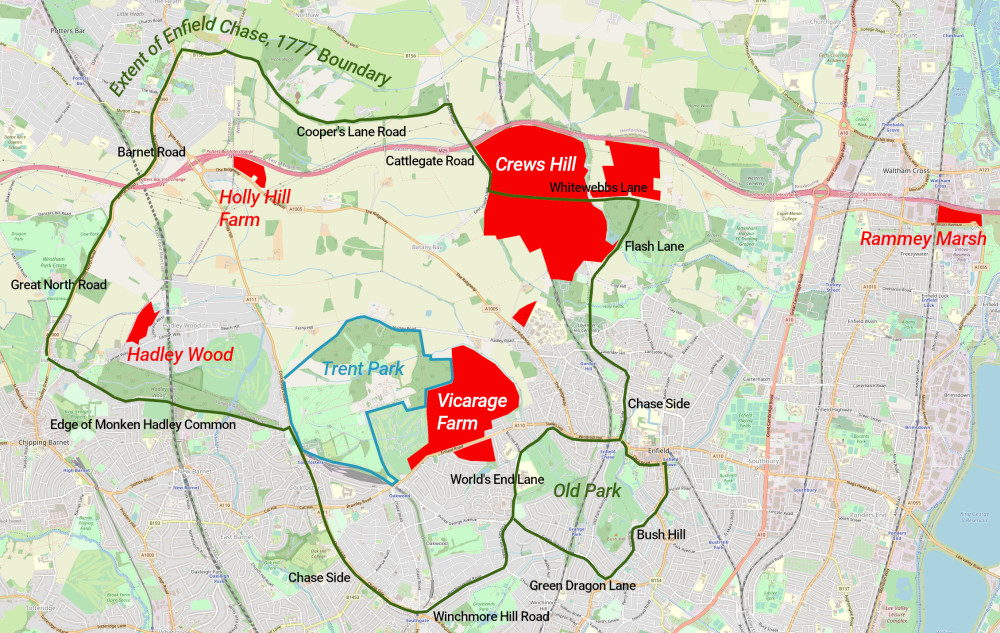This article, by Chairman Dave Cockle, appears in the July 2021 edition of the Enfield Dispatch.
See also the full digitised edition of David Pam’s book The Story of Enfield Chase, published by The Enfield Preservation Society in 1986.
Court records indicate that in 1557, Queen Elizabeth I was escorted from Hatfield to Enfield Chase by a retinue of twelve ladies in white satin, on ambling palfreys, and a hundred and twenty yeomen in green, on horseback, so that she might hunt hart. On entering the Chase she was met by fifty archers in scarlet boots and yellow caps, armed with gilded bows, each of whom presented her with a silver headed arrow, winged with peacock feathers. When the buck was taken, the Princess was pleased to be allowed the privilege of cutting his throat.
Enfield Royal Chase originated in Enfield Wood, part of the great Forest of Middlesex, which extended as far south as the River Thames. William I gave the manors of Edmonton and Enfield to Geoffrey de Mandeville after the Norman Conquest. The Chase was created around 1140-4, and the name ‘Enfield Chase’ first appears in public records in 1326.

The Chase was stocked with young deer raised at Enfield Old Park, now Enfield Golf Course, Bush Hill Park Golf Course, and the Town Park. John Norden’s map of 1593 shows the relationship between the fenced Park and the Chase. The Postern Gate, located in the approximate location of the modern Postern Green, provided access from Enfield village into the Chase.
Medieval fish ponds shown on Norden’s map can still be seen at Boxer’s Lake and at Pond Wood near Potters Bar. The remains of a medieval moated manor can still be seen at Camlet Moat, and also a Keeper’s fortified house at Enfield Golf Course.
The medieval peasant economy of Enfield relied on common rights within the Chase, including pannage (fattening of pigs on acorns and beech-mast), gathering of firewood and hunting small game. The Domesday Book estimated that the Manor of Enfield supported 2,000 swine, and it seems likely that the name Hog Hill at Enfield Chase (north of Slades Hill) is a reference to pannage within what would have then been woodland.

The people of Enfield Parish had a history of violent resistance to encroachment on their rights. In the 1650s parliamentary commissioners, anxious for revenue, sold off a large part of the Chase, mainly to army officers. The commoners complained that they had lost most of their timber and half of their grazing rights, and that the allocation of land had been unfair. In 1659 the commoners gathered with pitchforks and scythes, and tore down fences erected by ‘Intruders’ trying to enclose the Chase. Soldiers retaliated by shooting their sheep and cattle, and in the affray two or three commoners were killed, but the soldiers were overpowered, violently beaten, and carried off to Newgate prison. Around this time radical local ‘clergyman’ William Covell wrote pamphlets brimming with enlightened ideas, including collective farming on the Chase and taxation to pay for elderly care. Enfield hosted a number of communities with radical ideas, including Levellers, Diggers, and later Quakers.
In 1723 the Whig government passed the so-called ‘Black Act’ to criminalise the use of camouflage by suspected poachers at Enfield Chase and elsewhere. This legislation was in part at the petition of the Rangers of Enfield Chase, including men such as Sir Basil Firebrace and later General John Pepper, who lived at the Rangers House, now part of Bush Hill Park Golf Club.
Wealthy and powerful people came to view the Chase as unproductive waste land. Extraction of profit from the Chase ultimately led to the Act for the Division of Enfield Chase in 1777. The Act included provision for the creation of a miniature deer park, now Trent Park, which was gifted by George III to his physician, Dr Jebb, who had travelled to Trento in Italy where he successfully treated the Duke of Gloucester (the King’s younger brother) for mental illness.
The poet John Keats was educated at Clarke’s Academy (where Enfield Town Station now stands), a progressive institution which fomented a culture of dissent and forms an important backdrop to Keats’ poetry, including classics such as To Autumn, which was also influenced by the Enfield countryside of his childhood. Further enclosure of the Chase in 1803 (at which time Chase Green was created) inflamed Keats and other Romantic poets. Charles and Mary Lamb, authors of the popular Tales from Shakespeare, lived at nearby Gentleman’s Row next to the Chase and received distinguished visitors including their friend William Wordsworth.
The last major developments on the Chase took place at South Lodge (now the Lowther/Merryhills Drive area) in 1935 but thankfully much of the countryside of the Chase can still be enjoyed today, at places such as Trent Park, Fir and Pond Wood, and along rights of way at Salmons Brook, the Merryhills Way across Vicarage Farm, and a number of permissive paths in the area.

June 2021
Further Reading
E. P. Thompson, Whigs and Hunters: The Origin of the Black Act
Christopher Hill, World Turned Upside Down
David Pam, The Story of Enfield Chase
JM Patrick, William Covell and the Troubles at Enfield in 1659
Matthew Clark, The Gentry, the Commons, and the Politics of Common Right in Enfield, c. 1558 – 1603
Nicholas Roe, John Keats and the Culture of Dissent
Readers may also like to look at the latest book to be published by The Society on the History of Enfield Chase by Martin Paine. Download your copy here.




